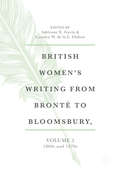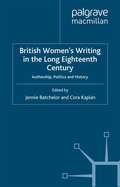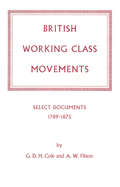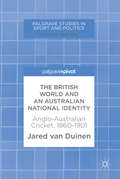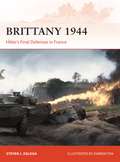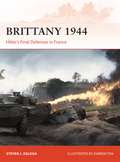- Table View
- List View
British Women's Writing from Brontë to Bloomsbury, Volume 2: 1860s and 1870s (British Women’s Writing from Brontë to Bloomsbury, 1840-1940 #2)
by Adrienne E. Gavin Carolyn W. de la L. OultonThis five-volume series, British Women’s Writing From Brontë to Bloomsbury, 1840–1940, historicallycontextualizes and traces developments in women’s fiction from 1840 to 1940. Critically assessingboth canonical and lesser-known British women’s writing decade by decade, it redefines the landscapeof women’s authorship across a century of dynamic social and cultural change. With each ofits volumes devoted to two decades, the series is wide in scope but historically sharply defined.Volume 2: 1860s and 1870s continues the series by historically and culturally contextualizing Victorianwomen’s writing distinctly within the 1860s and 1870s. Covering a range of fictional approaches,including short stories, religiously inflected novels, and comic writing the volume’s 16 original essaysconsider such developments as the sensation craze, the impact of new technologies, and the careeropportunities opening for women. Centrally, it reassesses key nineteenth-century female authors inthe context in which they first published while also recovering neglected women writers who helpedto shape the literary landscape of the 1860s and 1870s.
British Women’s Writing from Brontë to Bloomsbury, Volume 3: 1880s and 1890s (British Women's Writing from Brontë to Bloomsbury, 1840–1940 #3)
by Adrienne E. Gavin Carolyn W. de la L. OultonThis five-volume series, British Women’s Writing From Brontë to Bloomsbury, 1840–1940, historically contextualizes and traces developments in women’s fiction from 1840 to 1940. Critically assessing both canonical and lesser-known British women’s writing decade by decade, it redefines the landscape of women’s authorship across a century of dynamic social and cultural change. With each of its volumes devoted to two decades, the series is wide in scope but historically sharply defined. Volume 3: 1880s and 1890s analyses confluences and developments in women’s writing across two fin-de-siècle decades. Its 16 original essays reconsider fiction by canonical and lesser-known women writers, redefining the landscape of female authorship during these decades. By exploring women’s fiction within the social and cultural contexts of the 1880s and 1890s, the collection distils in terms of women’s writing how these decades discretely build on earlier work that is identifiably Victorian. The last two decades of the century, in distinctive ways, witnessed literary experiment, reflection on the limits of realism, and a fruitful sense of confusion about what was ending and what was about to begin.
British Women's Writing in the Long Eighteenth Century: Authorship, Politics and History
by J. Batchelor C. KaplanA constellation of new essays on authorship, politics and history, British Women's Writing in the Long Eighteenth Century: Authorship, Politics and History presents the latest thinking about the debates raised by scholarship on gender and women's writing in the long eighteenth century. The essays highlight the ways in which women writers were key to the creation of the worlds of politics and letters in the period, reading the possibilities and limits of their engagement in those worlds as more complex and nuanced than earlier paradigms would suggest. Contributors include Norma Clarke, Janet Todd, Brian Southam , Harriet Guest, Isobel Grundy and Felicity Nussbaum. Published in association with the Chawton House Library, Hampshire - for more information, visit http://www.chawton.org/
The British Working Class 1832-1940
by Andrew AugustIn this insightful new study, Andrew August examines the British working class in the period when Britain became a mature industrial power, working men and women dominated massive new urban populations, and the extension of suffrage brought them into the political nation for the first time. Framing his subject chronologically, but treating it thematically, August gives a vivid account of working class life between the mid-nineteenth and mid-twentieth centuries, examining the issues and concerns central to working-class identity. Identifying shared patterns of experience in the lives of workers, he avoids the limitations of both traditional historiography dominated by economic determinism and party politics, and the revisionism which too readily dismisses the importance of class in British society.
The British Working Class 1832-1940
by Andrew AugustIn this insightful new study, Andrew August examines the British working class in the period when Britain became a mature industrial power, working men and women dominated massive new urban populations, and the extension of suffrage brought them into the political nation for the first time. Framing his subject chronologically, but treating it thematically, August gives a vivid account of working class life between the mid-nineteenth and mid-twentieth centuries, examining the issues and concerns central to working-class identity. Identifying shared patterns of experience in the lives of workers, he avoids the limitations of both traditional historiography dominated by economic determinism and party politics, and the revisionism which too readily dismisses the importance of class in British society.
The British working class in postwar film
by Philip GillettAn incidental pleasure of watching a film is what it tells us about the society in which it is made. Using a sociological model, The British working class in postwar film looks at how working-class people were portrayed in British feature films in the decade after the Second World War. Though some of the films examined are well known, others have been forgotten and deserve reassessment. Original statistical data is used to assess the popularity of the films with audiences. With its interdisciplinary approach and the avoidance of jargon, this book seeks to broaden the approach to film studies. Students of media and cultural studies are introduced to the skills of other disciplines, while sociologists and historians are encouraged to consider the value of film evidence in their own fields. This work should appeal to all readers interested in social history and in how cinema and society works.
The British World and an Australian National Identity: Anglo-Australian Cricket, 1860–1901 (Palgrave Studies in Sport and Politics)
by Jared Van DuinenThis book explores the dynamics of Anglo-Australian cricketing relations within the ‘British World’ in the late nineteenth and early twentieth centuries. It explores what these interactions can tell us about broader Anglo-Australian relations during this period and, in particular, the evolution of an Australian national identity. Sport was, and is, a key aspect of Australian culture. Jared van Duinen demonstrates how sport was used to rehearse an identity that would then emerge in broader cultural and political terms. Using cricket as a case study, this book contributes to the ongoing historiographical debate about the nature and evolution of an Australian national identity.
British WW1 Biplane (large print)
by RnibThis page shows two views of a World War 1 military plane. There is a locator dot shown, which will be at the top left, when the image is the correct way up. There is a side view facing to the left on the left of the page and a top view on the right of the page. On the left of the side view is a large two-bladed wooden propeller. To the right is the engine fairing. On the top of this is a machine gun facing to the left. To the right up and down from the gun are the end edges of two wings. The upper wing is slightly to the left (forward) of the lower wing. There are two long wooden vertically slanting struts between the wings. A second pair of short struts goes between the upper wing and the body of the plane. Down from the lower wing are two more struts which lead to the plane's wheels. From the wings, the plane's fuselage stretches out to the right. Between the wings in the top of the fuselage is the rounded recess of the cockpit. Halfway along the fuselage it is marked with a large letter G and a British blue, white and red roundel. At the end of the fuselage is the tail. The vertical part is divided into two halves. The half to the right is an aileron which can be moved to adjust the plane's flight path. It is decorated with a blue, white and red stripe. Just the end edge of the horizontal part of the tail can be found. Down from the tail is the tail skid, a small short strut which rests on the ground when the plane is stationary and protects the tail on takeoff and landing. The top view shows the plane facing up the page. The propeller is at the top centre of the page. Down from this is the front of the engine fairing. The tips of two machine guns poke out, sitting on top of the fairing. Then the top wing stretches to the right and left. In the centre of the wing there is a rectangular hatch through the wing. The upper wing is decorated with two British blue, white and red roundels, one to the left and one to the right. In the bottom right and left of the wings is an aileron which can be moved to adjust the plane's flight path. The upper wing is slightly up the page from the lower wing, so only the rear part of the lower wing can be found. Down the page from the centre of the wings is the top of the fuselage. In the first part of it half the rounded cockpit shows through a rounded recess in the upper wing. The other half of the cockpit is hidden by the upper wing. At the bottom of the page at the end of the fuselage is the tail. The rear part of each tail piece is an aileron which can be moved to adjust the plane's flight path. The biplane is painted khaki green. There are many wires going between the wings, and the wings and the body. They are a tension structures to act against the resistance of the wooden struts for structural strength. The machine gun fires through the sweep of the propeller but the firing is ingeniously timed not to hit the propeller blades.
British WW1 Biplane (UEB contracted)
by RnibThis page shows two views of a World War 1 military plane. There is a locator dot shown, which will be at the top left, when the image is the correct way up. There is a side view facing to the left on the left of the page and a top view on the right of the page. On the left of the side view is a large two-bladed wooden propeller. To the right is the engine fairing. On the top of this is a machine gun facing to the left. To the right up and down from the gun are the end edges of two wings. The upper wing is slightly to the left (forward) of the lower wing. There are two long wooden vertically slanting struts between the wings. A second pair of short struts goes between the upper wing and the body of the plane. Down from the lower wing are two more struts which lead to the plane's wheels. From the wings, the plane's fuselage stretches out to the right. Between the wings in the top of the fuselage is the rounded recess of the cockpit. Halfway along the fuselage it is marked with a large letter G and a British blue, white and red roundel. At the end of the fuselage is the tail. The vertical part is divided into two halves. The half to the right is an aileron which can be moved to adjust the plane's flight path. It is decorated with a blue, white and red stripe. Just the end edge of the horizontal part of the tail can be found. Down from the tail is the tail skid, a small short strut which rests on the ground when the plane is stationary and protects the tail on takeoff and landing. The top view shows the plane facing up the page. The propeller is at the top centre of the page. Down from this is the front of the engine fairing. The tips of two machine guns poke out, sitting on top of the fairing. Then the top wing stretches to the right and left. In the centre of the wing there is a rectangular hatch through the wing. The upper wing is decorated with two British blue, white and red roundels, one to the left and one to the right. In the bottom right and left of the wings is an aileron which can be moved to adjust the plane's flight path. The upper wing is slightly up the page from the lower wing, so only the rear part of the lower wing can be found. Down the page from the centre of the wings is the top of the fuselage. In the first part of it half the rounded cockpit shows through a rounded recess in the upper wing. The other half of the cockpit is hidden by the upper wing. At the bottom of the page at the end of the fuselage is the tail. The rear part of each tail piece is an aileron which can be moved to adjust the plane's flight path. The biplane is painted khaki green. There are many wires going between the wings, and the wings and the body. They are a tension structures to act against the resistance of the wooden struts for structural strength. The machine gun fires through the sweep of the propeller but the firing is ingeniously timed not to hit the propeller blades.
British WW1 Biplane (UEB uncontracted)
by RnibThis page shows two views of a World War 1 military plane. There is a locator dot shown, which will be at the top left, when the image is the correct way up. There is a side view facing to the left on the left of the page and a top view on the right of the page. On the left of the side view is a large two-bladed wooden propeller. To the right is the engine fairing. On the top of this is a machine gun facing to the left. To the right up and down from the gun are the end edges of two wings. The upper wing is slightly to the left (forward) of the lower wing. There are two long wooden vertically slanting struts between the wings. A second pair of short struts goes between the upper wing and the body of the plane. Down from the lower wing are two more struts which lead to the plane's wheels. From the wings, the plane's fuselage stretches out to the right. Between the wings in the top of the fuselage is the rounded recess of the cockpit. Halfway along the fuselage it is marked with a large letter G and a British blue, white and red roundel. At the end of the fuselage is the tail. The vertical part is divided into two halves. The half to the right is an aileron which can be moved to adjust the plane's flight path. It is decorated with a blue, white and red stripe. Just the end edge of the horizontal part of the tail can be found. Down from the tail is the tail skid, a small short strut which rests on the ground when the plane is stationary and protects the tail on takeoff and landing. The top view shows the plane facing up the page. The propeller is at the top centre of the page. Down from this is the front of the engine fairing. The tips of two machine guns poke out, sitting on top of the fairing. Then the top wing stretches to the right and left. In the centre of the wing there is a rectangular hatch through the wing. The upper wing is decorated with two British blue, white and red roundels, one to the left and one to the right. In the bottom right and left of the wings is an aileron which can be moved to adjust the plane's flight path. The upper wing is slightly up the page from the lower wing, so only the rear part of the lower wing can be found. Down the page from the centre of the wings is the top of the fuselage. In the first part of it half the rounded cockpit shows through a rounded recess in the upper wing. The other half of the cockpit is hidden by the upper wing. At the bottom of the page at the end of the fuselage is the tail. The rear part of each tail piece is an aileron which can be moved to adjust the plane's flight path. The biplane is painted khaki green. There are many wires going between the wings, and the wings and the body. They are a tension structures to act against the resistance of the wooden struts for structural strength. The machine gun fires through the sweep of the propeller but the firing is ingeniously timed not to hit the propeller blades.
British WW1 Tank (large print)
by RnibThis page shows two views of an early World War 1 tank. There is a locator dot shown, which will be at the top left, when the image is the correct way up. There is a side view facing to the left at the top of the page and a front view in the bottom left of the page. On the side view there is a heavy dashed line around the body of the tank, representing its caterpillar track. In the middle of the side wall of the tank is a sponson with a cannon poking out and forwards. On the right is a radiator grill. The front view shows how the sponsons on each side of the tank stick out from the side wall of the tank. A cannon pokes out from a cylindrical part of the sponson. This allows the cannon to be rotated to give a wider range of fire. In from the sponsons is the leading edge of the two large segmented caterpillar tracks. In the top centre of the image are two hatch covers which could be opened allowing the occupants to see out.
British WW1 Tank (UEB contracted)
by RnibThis page shows two views of an early World War 1 tank. There is a locator dot shown, which will be at the top left, when the image is the correct way up. There is a side view facing to the left at the top of the page and a front view in the bottom left of the page. On the side view there is a heavy dashed line around the body of the tank, representing its caterpillar track. In the middle of the side wall of the tank is a sponson with a cannon poking out and forwards. On the right is a radiator grill. The front view shows how the sponsons on each side of the tank stick out from the side wall of the tank. A cannon pokes out from a cylindrical part of the sponson. This allows the cannon to be rotated to give a wider range of fire. In from the sponsons is the leading edge of the two large segmented caterpillar tracks. In the top centre of the image are two hatch covers which could be opened allowing the occupants to see out.
British WW1 Tank (UEB uncontracted)
by RnibThis page shows two views of an early World War 1 tank. There is a locator dot shown, which will be at the top left, when the image is the correct way up. There is a side view facing to the left at the top of the page and a front view in the bottom left of the page. On the side view there is a heavy dashed line around the body of the tank, representing its caterpillar track. In the middle of the side wall of the tank is a sponson with a cannon poking out and forwards. On the right is a radiator grill. The front view shows how the sponsons on each side of the tank stick out from the side wall of the tank. A cannon pokes out from a cylindrical part of the sponson. This allows the cannon to be rotated to give a wider range of fire. In from the sponsons is the leading edge of the two large segmented caterpillar tracks. In the top centre of the image are two hatch covers which could be opened allowing the occupants to see out.
Britishness since 1870
by Paul WardWhat does it mean to be British? It is now recognized that being British is not innate, static or permanent, but that national identities within Britain are constantly constructed and reconstructed. Britishness since 1870 examines this definition and redefinition of the British national identity since the 1870s. Paul Ward argues that British national identity is a resilient force, and looks at how Britishness has adapted to changing circumstances. Taking a thematic approach, Britishness since 1870 examines the forces that have contributed to a sense of Britishness, and considers how Britishness has been mediated by other identities such as class, gender, region, ethnicity and the sense of belonging to England, Scotland, Wales and Ireland.
Britishness since 1870
by Paul WardWhat does it mean to be British? It is now recognized that being British is not innate, static or permanent, but that national identities within Britain are constantly constructed and reconstructed. Britishness since 1870 examines this definition and redefinition of the British national identity since the 1870s. Paul Ward argues that British national identity is a resilient force, and looks at how Britishness has adapted to changing circumstances. Taking a thematic approach, Britishness since 1870 examines the forces that have contributed to a sense of Britishness, and considers how Britishness has been mediated by other identities such as class, gender, region, ethnicity and the sense of belonging to England, Scotland, Wales and Ireland.
The Briton: Homespun Bride The Briton
by Catherine PalmerIndulge your fantasies of delicious Regency Rakes, fierce Viking warriors and rugged Highlanders. Be swept away into a world of intense passion, lavish settings and romance that burns brightly through the centuries Lady Bronwen, proud inheritor of the ancient ways of the Britons, had lost all she held dear.
Britons: Forging the Nation 1707-1837
by Linda ColleyHow was Great Britain made? And what does it mean to be British? This brilliant and seminal book examines how a more cohesive British nation was invented after 1707 and how this new national identity was nurtured through war, religion, trade, and empire. Lavishly illustrated and powerful, Britons remains a major contribution to our understanding of Britain’s past, and continues to influence ongoing controversies about this polity’s survival and future. This edition contains an extensive new preface by the author. “A sweeping survey, . . . evocatively illustrated and engagingly written.”—Harriet Ritvo, New York Times Book Review “Challenging, fascinating, enormously well informed.”—John Barrell, London Review of Books “Linda Colley writes with clarity and grace...Her stimulating book will be, and deserves to be influential”—E. P. Thompson, Dissent Linda Colley is Shelby M. C. Davis 1958 Professor of History at Princeton University. Winner of the Wolfson History PrizeNew York Times NotableBook
The Britons (The Peoples of Europe #9)
by Christopher A. SnyderThis book provides a fascinating and unique history of the Britons from the late Iron Age to the late Middle Ages. It also discusses the revivals of interest in British culture and myth over the centuries, from Renaissance antiquarians to modern day Druids. A fascinating and unique history of the Britons from the late Iron Age to the late Middle Ages. Describes the life, language and culture of the Britons before, during and after Roman rule. Examines the figures of King Arthur and Merlin and the evolution of a powerful national mythology. Proposes a new theory on the Anglo-Saxon settlement of Britain and the establishment of separate Brittonic kingdoms. Discusses revivals of interest in British culture and myth, from Renaissance antiquarians to modern day Druids.
Britons and their Battlefields: War, Memory, and Commemoration since the Fourteenth Century
by Ian AthertonWhile much attention has been paid to the commemoration of conflict in the twentieth century, this book is the first to consider conflict memory in the long term, arguing that modern practices were not created out of the mud of the trenches, but evolved from much longer practices. From the fourteenth century to the present day, this work analyses the changing commemoration and memories of British battlefields at home and overseas, from Bannockburn (1314) to Bosworth (1485) to Basra (1914-1921). Across these seven centuries, there have been a series of recurring post-battle rituals that have shaped and continue to shape memories of conflict. Three distinct but overlapping periods of memory can be delineated: In the later Middle Ages battlefields were consecrated by the burial of the fallen and often by the erection of a battlefield cross, or chapel or chantry to pray for the dead. The second phase began with the Protestant Reformation in the 1530s, when pilgrimage and prayers for the dead was abolished, and battlefield chantries were dissolved and many battlefield crosses were demolished. Memories shifted from the dead to the living, especially the bodies of surviving veterans who commemorated the conflict by their wounds, and from soil and stone to print and ink. The third phase began in the eighteenth century when antiquaries and others established new monuments on past battlefields. Monuments to survivors and the dead were established on contemporary battlefields such as Waterloo, once again hailed as sacred ground hallowed by bloodshed, fit destinations for a pilgrimage. Not just officers but ordinary soldiers began to be memorialized by name on the battlefield, culminating in the cult of the names of the dead enshrined by the creation of the War Graves Commission in 1917, and the idea that battlefields should be preserved unchanged as seen in modern heritage management. Drawing on a wide variety of literary and historical sources and taking a uniquely longue durée approach, the book explores and links memory-making practices from across the period to reconsider the ways in which battlefields are commemorated and re-commemorated. In so doing, it makes a unique contribution to a wide range of historiographical fields: British history since the fourteenth century, memory studies, heritage studies, landscape history, conflict archaeology, and military history.
Britons and their Battlefields: War, Memory, and Commemoration since the Fourteenth Century
by Ian AthertonWhile much attention has been paid to the commemoration of conflict in the twentieth century, this book is the first to consider conflict memory in the long term, arguing that modern practices were not created out of the mud of the trenches, but evolved from much longer practices. From the fourteenth century to the present day, this work analyses the changing commemoration and memories of British battlefields at home and overseas, from Bannockburn (1314) to Bosworth (1485) to Basra (1914-1921). Across these seven centuries, there have been a series of recurring post-battle rituals that have shaped and continue to shape memories of conflict. Three distinct but overlapping periods of memory can be delineated: In the later Middle Ages battlefields were consecrated by the burial of the fallen and often by the erection of a battlefield cross, or chapel or chantry to pray for the dead. The second phase began with the Protestant Reformation in the 1530s, when pilgrimage and prayers for the dead was abolished, and battlefield chantries were dissolved and many battlefield crosses were demolished. Memories shifted from the dead to the living, especially the bodies of surviving veterans who commemorated the conflict by their wounds, and from soil and stone to print and ink. The third phase began in the eighteenth century when antiquaries and others established new monuments on past battlefields. Monuments to survivors and the dead were established on contemporary battlefields such as Waterloo, once again hailed as sacred ground hallowed by bloodshed, fit destinations for a pilgrimage. Not just officers but ordinary soldiers began to be memorialized by name on the battlefield, culminating in the cult of the names of the dead enshrined by the creation of the War Graves Commission in 1917, and the idea that battlefields should be preserved unchanged as seen in modern heritage management. Drawing on a wide variety of literary and historical sources and taking a uniquely longue durée approach, the book explores and links memory-making practices from across the period to reconsider the ways in which battlefields are commemorated and re-commemorated. In so doing, it makes a unique contribution to a wide range of historiographical fields: British history since the fourteenth century, memory studies, heritage studies, landscape history, conflict archaeology, and military history.
Brittany 1944: Hitler’s Final Defenses in France (Campaign)
by Steven J. Zaloga Darren TanOne of the prime objectives for the Allies following the D-Day landings was the capture of sufficient ports to supply their armies. The original Overlord plans assumed that ports along the Breton coast would be essential to expansion of the Normandy beach-head. This included the major ports at Brest and on Quiberon Bay.The newly arrived Third US Army (TUSA) under Lt. Gen. George S. Patton was delegated to take on the Brittany mission. In one of the most rapid mechanized advances of the war, TUSA had the ports of Avranches and Quiberon encircled by the second week of August 1944.But changing priorities meant that most of TUSA was redeployed, meaning only a single corps was left to take the Breton port cities. The fight would drag into 1945, long after German field armies had been driven from France. Using full colour maps and artwork as well as contemporary accounts and photographs, Brittany 1944 is the fascinating story of the siege of Germany's last bastions on the French Atlantic coast.
Brittany 1944: Hitler’s Final Defenses in France (Campaign #320)
by Steven J. Zaloga Darren TanOne of the prime objectives for the Allies following the D-Day landings was the capture of sufficient ports to supply their armies. The original Overlord plans assumed that ports along the Breton coast would be essential to expansion of the Normandy beach-head. This included the major ports at Brest and on Quiberon Bay.The newly arrived Third US Army (TUSA) under Lt. Gen. George S. Patton was delegated to take on the Brittany mission. In one of the most rapid mechanized advances of the war, TUSA had the ports of Avranches and Quiberon encircled by the second week of August 1944.But changing priorities meant that most of TUSA was redeployed, meaning only a single corps was left to take the Breton port cities. The fight would drag into 1945, long after German field armies had been driven from France. Using full colour maps and artwork as well as contemporary accounts and photographs, Brittany 1944 is the fascinating story of the siege of Germany's last bastions on the French Atlantic coast.
Brittany in the Early Middle Ages: Texts and Societies
by Wendy DaviesThis volume focuses on Wendy Davies's work on early medieval Breton texts and their implications. Beginning with core analyses of the Redon and Landévennec cartularies, it continues with papers that tease out some of the key social implications of the 9th-century Redon material - on the nature of political power, on rural communities, on the settlement of disputes, and on transmission of property. While the Redon charters have long been known as a source of fundamental importance for Breton history, the author's database (established in the 1980s) allowed much greater understanding of the role of individuals - at all social levels, and particularly peasant level - than had previously been possible. Attention to the detail of the east Breton past also includes papers on some of the results of her fieldwork, on building stone in particular. Early medieval Brittany is not merely interesting in itself (and it is certainly not some Celtic backwater): Breton evidence can usefully be differentiated from the evidence of other Celtic areas and has a significant role in wider issues of European history. As well as papers on the familiar themes of kingship, rulership, cult sites and cemeteries, the final section highlights the distinctive quality of the Breton evidence for the protection of sacred and personal space, for slavery and serfdom and for village-level courts.
Brittany in the Early Middle Ages: Texts and Societies
by Wendy DaviesThis volume focuses on Wendy Davies's work on early medieval Breton texts and their implications. Beginning with core analyses of the Redon and Landévennec cartularies, it continues with papers that tease out some of the key social implications of the 9th-century Redon material - on the nature of political power, on rural communities, on the settlement of disputes, and on transmission of property. While the Redon charters have long been known as a source of fundamental importance for Breton history, the author's database (established in the 1980s) allowed much greater understanding of the role of individuals - at all social levels, and particularly peasant level - than had previously been possible. Attention to the detail of the east Breton past also includes papers on some of the results of her fieldwork, on building stone in particular. Early medieval Brittany is not merely interesting in itself (and it is certainly not some Celtic backwater): Breton evidence can usefully be differentiated from the evidence of other Celtic areas and has a significant role in wider issues of European history. As well as papers on the familiar themes of kingship, rulership, cult sites and cemeteries, the final section highlights the distinctive quality of the Breton evidence for the protection of sacred and personal space, for slavery and serfdom and for village-level courts.
